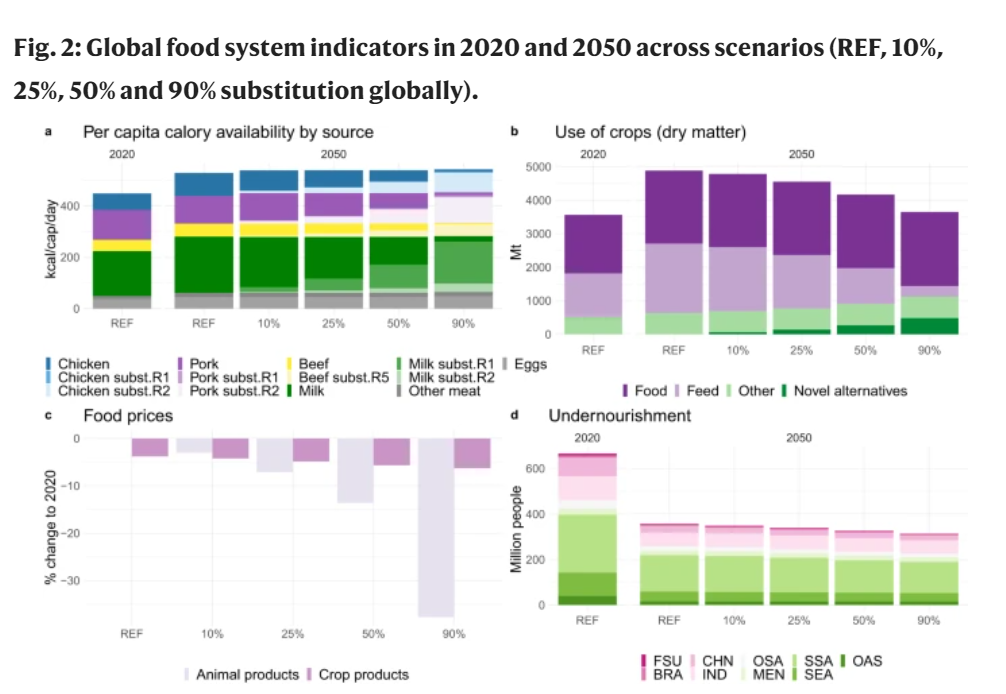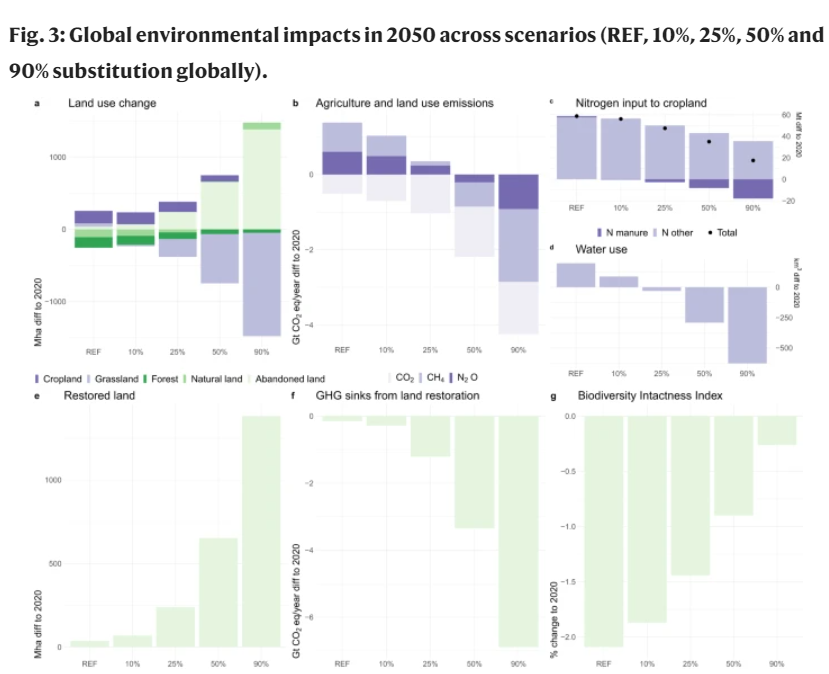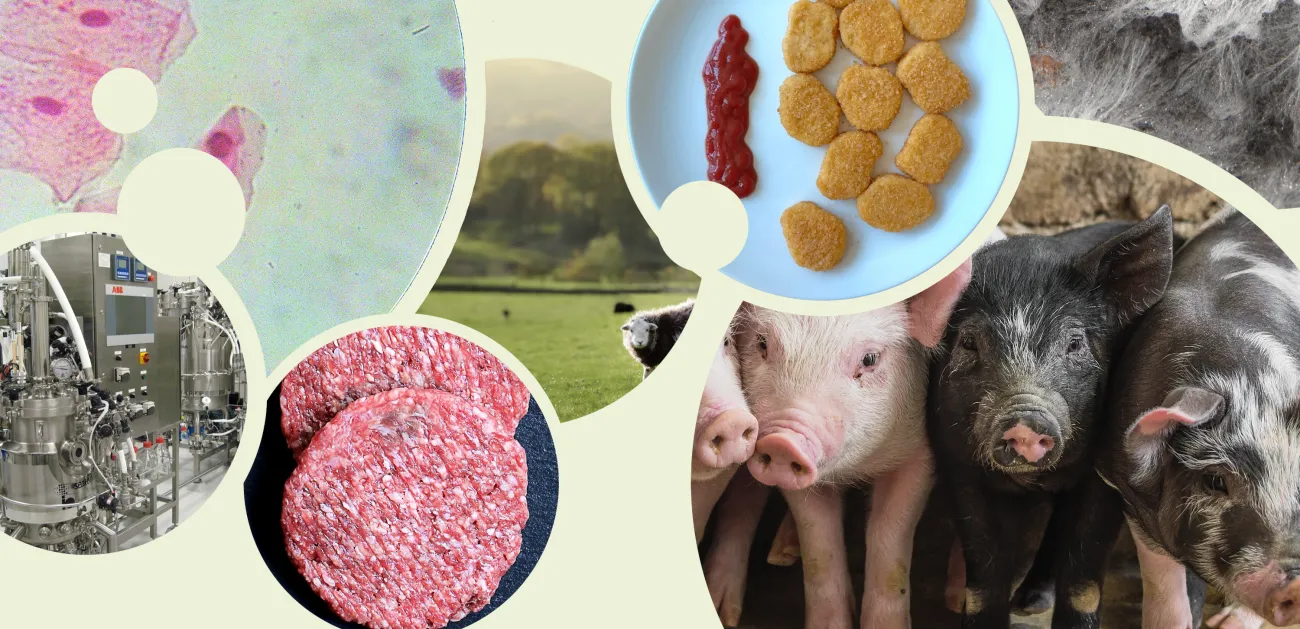This paper is the first system-wide assessment of the effects of substituting animal based products with novel plant based alternatives on a range of food system concerns . The paper analyses four substitution scenarios (corresponding to 10%, 25%, 50% and 90% incremental substitution from 2020 to 2050) and determines the net results for food system outcomes including food availability, undernourishment levels, crop use and food prices, and environmental outcomes including land use change, emissions reduction, biodiversity intactness and nitrogen input.

Summary
In order to assess the outcomes of this substitution, the paper uses a selection of hypothetical plant-based recipes, designed using realistic ingredients that could be produced with existing local food manufacturing capabilities and supply, and that matched the nutrient profile of original animal-derived products. These recipes were used to produce a business as usual scenario, as well as four scenarios in which animal products are replaced in global diets incrementally over the course of 30 years (to 2050) by differing degrees. The scenarios were then analysed using the global biosphere management model (GLOBIOM) that compares the implications of land use competition between agriculture, forestry and bioenergy. In the business as usual scenario global food demand increases, translating to increases in per capita animal product consumption (with chicken demand increasing the most at 38%) and total crop demand increases due to higher feed use. This exerts further pressure on natural resources, with land use increasing by 4%, nitrogen use by 39% and water use by 6%. Related GHG emissions increase by 15% and biodiversity intactness declines by 2.1%.
In alternative scenarios, total crop demand decreases (due to reduced feed) compared to business as usual and is not offset by the increased demand for producing plant based alternatives. Lower demand translates to price reductions for crops and products, resulting in increased food security and food availability. In the scenario where 50% of animal products are substituted, all impacts on natural resources decline significantly, with a 12% decline in agricultural area and halving of nitrogen inputs. Whilst livestock reduction reduces the availability of fertility from manure by 6.4 Mt compared to business as usual, savings in the cropland nitrogen input requirements are almost five times larger (27.8 Mt decrease in inputs required). A 50% substitution is enough to eliminate global deforestation for agricultural land use and leads to a decline in GHG emissions by 2.1 Gt CO2eq year−1 (31%) in 2050 without accounting for any carbon sequestration on spared land. If additional measures are taken to restore abandoned agricultural land through afforestation, carbon sequestration grows by 3.3 Gt CO2 year−1 in 2050, doubling the benefits of dietary change. This would also have significant benefits for biodiversity, with the decrease of biodiversity intactness limited to 0.9% (instead of 2.1% in business as usual scenario). The two figures below show a comparison of the food system (fig.2) and environmental indicators (fig.3) across the four scenarios.

Fig 2. Global food system indicators in 2020 and 2050 across scenarios

Fig 3. Global environmental impacts in 2050 across scenarios
The authors conclude that a global dietary shift to novel plant based products in place of animal products could create profound system-wide economic and environmental impacts. Given that a large part of GHG reduction comes from methane reductions, these results could also have significant near-term climate mitigation benefits (for more on the implications of reducing agriculture methane emissions see our explainer or watch our recent event). The results show that reductions above 50% in animal product consumption are particularly impactful when combined with land restoration and conservation, and could deliver results in line with ambitious climate change mitigation and biodiversity conservation goals. However the authors highlight three ramifications of this transition that would need to be addressed:
- Decreased demand for (and consequently lower prices for) livestock could lead to lower productivity and higher emissions intensity. This creates a rebound effect that reduces the net environmental benefit. This highlights the need for simultaneous interventions both on the supply and the demand side to accelerate the speed of transformation towards sustainable food systems
- Broader economic impacts on, for example, employment and farmers’ livelihoods were not included in analysis, but will likely be negatively impacted. Appropriate policy and management efforts will be needed to support a socially just transition for farmers. This could be supported by livelihood diversification or new employment opportunities through natural capital frameworks and ecosystem service payments.
- Whilst the overall demand for fertiliser inputs was significantly reduced, there remain complex interlinkages in mixed farming systems among feed, fertiliser, and soil quality that need to be considered. Livestock farming also plays a significant cultural role and in lower income countries functions as a safety net and a diversification mechanism.
- Potential negative impacts of price declines on the producers of agricultural commodities, which could be substantial are also not considered.
Abstract
Plant-based animal product alternatives are increasingly promoted to achieve more sustainable diets. Here, we use a global economic land use model to assess the food system-wide impacts of a global dietary shift towards these alternatives. We find a substantial reduction in the global environmental impacts by 2050 if globally 50% of the main animal products (pork, chicken, beef and milk) are substituted—net reduction of forest and natural land is almost fully halted and agriculture and land use GHG emissions decline by 31% in 2050 compared to 2020. If spared agricultural land within forest ecosystems is restored to forest, climate benefits could double, reaching 92% of the previously estimated land sector mitigation potential. Furthermore, the restored area could contribute to 13-25% of the estimated global land restoration needs under target 2 from the Kunming Montreal Global Biodiversity Framework by 2030, and future declines in ecosystem integrity by 2050 would be more than halved. The distribution of these impacts varies across regions—the main impacts on agricultural input use are in China and on environmental outcomes in Sub-Saharan Africa and South America. While beef replacement provides the largest impacts, substituting multiple products is synergistic.
Reference
Kozicka, M., Havlík, P., Valin, H., Wollenberg, E., Deppermann, A., Leclère, D., Lauri, P., Moses, R., Boere, E., Frank, S. and Davis, C., 2023. Feeding climate and biodiversity goals with novel plant-based meat and milk alternatives. Nature Communications, 14(1), p.5316.
Find the full article here, as well as our blog on the emissions from plant based products




Comments (0)